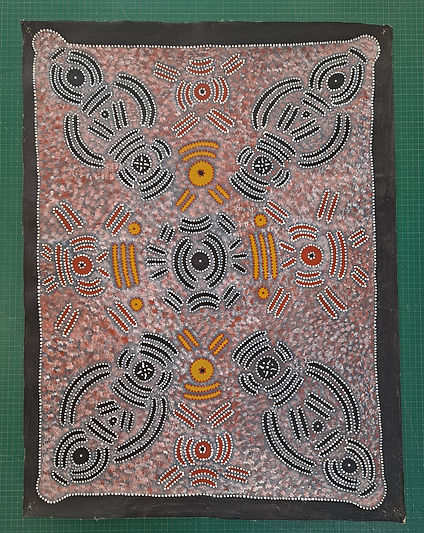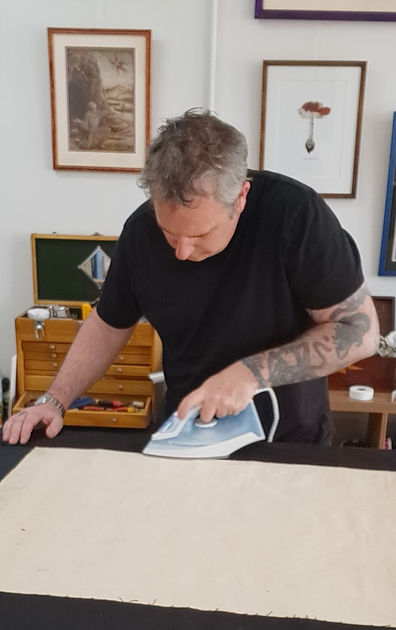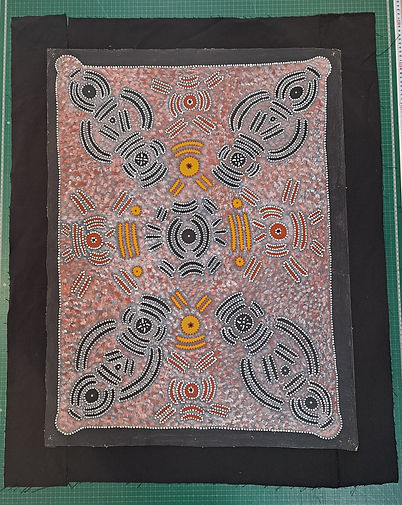Every now and then bring people me canvases which have either damaged edges or have been painted with insufficient space around the artwork to wrap it around stretcher bars, as in the picture below.

As you can see, particularly at the top left and bottom right corners, the edge of the painting is very close to the edge of the canvas. To get a good wrap around the stretcher bars it’s best to have about 50mm of canvas around the image but in this case it was around 20mm. While smaller canvases may be framed behind glass like works on paper, this is not an option for larger paintings, but they can be still be stretched using a process called strip-lining.
In brief, strip-lining involves extending and reinforcing the edges of the existing piece by affixing additional strips of canvas to the edges using a heat-activated adhesive.

I generally use strips of canvas five inches wide for strip-lining; two inches for the new perimeter and the other three to bond to the existing piece. My preferred fixitive is BEVA 371 film, which is an archival, heat-activated adhesive film. It’s expensive, and not always easy to find, but it’s the best thing for the job, easy to use and, even better, reversible. BEVA 371 is sold in rolls and comes with a paper backing on one side and a clear plastic covering on the other. Always start with the paper-backed side first and, if you get lost (the paper has a tendency to fall off, particularly once the film has been cut) the side with the adhesive exposed has a slightly dull, matte appearance compared to the protective plastic.
I cut three inch strips of BEVA 371, remove the backing paper and place the film face down on the rear edge of the artwork. Using an iron at a low setting (mine is set to “polyester” in the picture below) and using the backing paper removed previously to insulate the film from the surface of the iron, I make several passes across the length of the strip until it is completely adhered.

With one side of the film now fixed to all four rear edges of the artwork, I now peel the protective plastic from the other and begin to attach the canvas strips. Since I will be heating the adhesive through a layer of canvas this time, I set the iron to a higher temperature suitable for linen or canvas. Much the same as before, I work in a series of passes until the canvas strip are firmly fixed to the artwork with no peeling at the edges.

Now the painting has the additional canvas required to wrap it around the stretcher bars, though it’s a good idea to let the adhesive cool before moving on to stretching. I’m not a fan of stretching pliers in general, but I strongly advise against using them when a canvas has been strip-lined. Although the bond created by the BEVA 371 is strong, it’s still best to be careful, particularly if the strip-lining has been carried out to repair a damaged canvas. When a canvas is being stretched for display, I see little sense in putting too much tension into it anyway.

One downside of strip-lining, is that you are inevitably left with a fairly obvious join between the artwork and the lining since canvas is quite thick. I have tried to make this less obvious by lining with black strips in this case but I always recommend that strip-lined canvases, once stretched, be displayed in a float frame where the edges can be concealed.


I really appreciate this post, Shaun! I’m about to attempt strip-lining a canvas myself, but it’s a big one: 84″x60″. Would you still recommend using 3″ to adhere and only 2″ to wrap? Or would you recommend more than that, given the size of the painting? It will need a gallery wrap, so maybe I should do 3″ to wrap–but then, do I need to increase the amount of adhered canvas, just to make sure the bond is strong?
Also, if not using stretching pliers with strip-lined works, what do you use instead? Or do you just pull it taut with your hands?
Greatly appreciate your advice!
Hi Danielle, I’m glad you’ve found this post useful. The amount of wrap I use is dependent on the size of the bars – you just want it to leave you an inch or so at the back to staple so I find 2″ is enough for 30mm bars. For a larger canvas I think using 3″ to adhere is probably a good idea; whether it’s necessary or not I can’t say but it certainly couldn’t hurt!
The question of whether to use pliers or not comes down to your own strength. I can pull a canvas fairly tight by hand and I can also rip a poor-quality one quite easily with pliers so I generally stretch canvases for display by hand. If they’re just being hung on a wall they don’t need to be drum-tight and the majority of canvases I stretch are by Australian Indigenous artists who often don’t have access to high-quality materials so I’m quite anxious to avoid damaging the work in any way. For a canvas that size, you might find pliers a bit easier but keep an eye on the edges. All the strip-lining I have done has been for clients, so I have to admit I’ve never actually tested the strength of bond but I have noticed that, depending on the quality of the edges on the original canvas, they can lift a bit when stretched tight. You might be able to get around this by fraying the edges a little and adding another 1/4″ of BEVA for them to adhere to.
I hope this answers your questions. Please get in touch if you run into any trouble. Unfortunately, like most repair work, there are inevitable compromises which have to be made when strip-lining but the process is pretty straight forward and, because the adhesive is heat-activated, you can always warm it up again and peel the strips off or re-adhere if you get into trouble.
Thank you so much, Shaun, I truly appreciate your response and will definitely reach out if I do run into trouble (though hoping that doesn’t happen…)!
Thank you so much, Shaun, I truly appreciate your response and will definitely reach out if I do run into trouble (though hoping that doesn’t happen…)!